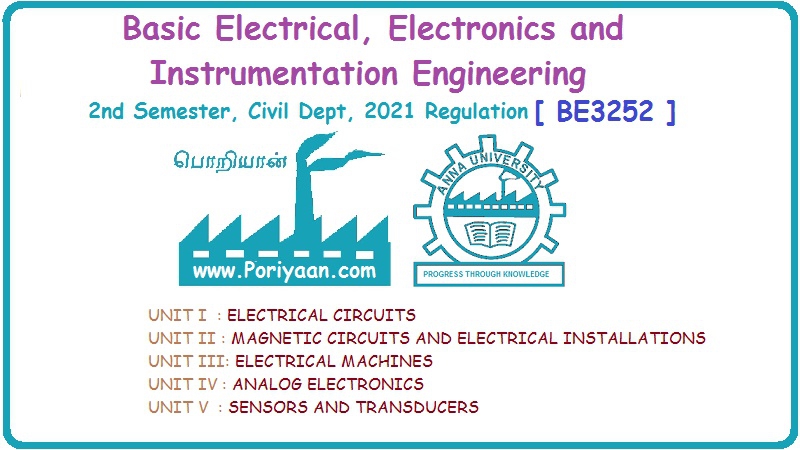Basic Electrical, Electronics And Instrumentation Engineering: UNIT I: Electrical Circuits
Single Phase Ac Circuits
Introduction
The resistance, inductance and capacitance are three basic elements of any electrical network. In order to analyze any electric circuit, it is necessary to understand the following three cases.
SINGLE
PHASE AC CIRCUITS
Introduction:
The
resistance, inductance and capacitance are three basic elements of any
electrical network. In order to analyze any electric circuit, it is necessary
to understand the following three cases.
1)
AC Through pure resistive circuit.
2)
AC Through pure inductive circuit.
3)
AC Through pure capacitive circuit.
AC through Pure
Resistance

Consider
a circuit consisting of a pure resistance 'R' ohms connected across a voltage
v=Vm sin ot. The circuit is shown in Figure 1.29.
According
to ohm's law the current equation is written as:

AC through Pure
Inductance

Pure
inductance has zero ohmic resistance. Its internal resistance is zero. The coil
has pure inductance of L henries (H).
According
to Faraday law of electromagnetic induction.

Thus
induced emf will oppose the supply voltage according to Lenz's law

The
above equations clearly shows that the current is purely sinusoidal and having
phase angle of - π/2 radians. i.e., - 90°. That means that the current lags
voltage applied by 90o.
The
inductive reactance is defined as the opposite offered by the inductance of a
circuit to the flow of an alternating sinusoidal current.

Power:
The
power equation can be obtained by taking the product of instantaneous voltage
and current.

The
average power over a one complete cycle is zero.
AC through Pure
Capacitor

Consider
a simple circuit consisting of a pure capacitor of C-farads, connected across a
voltage given by the equation:
v
= Vm sin ωt
The
circuit is shown in the Figure 1.33.
The
current i charges the capacitor C. The instantaneous charge 'q' on the plates
of the capacitor is given by:
q=CV
The
current through the capacitor is equal to rate of change of charge. S

The
current through the pure capacitor leads the voltage by the angle of π/2
radians.
The
capacitive reactance is defined as the resistance offered by the capacitor.

The
pure capacitor never consumes the power. The power factor for pure capacitive circuit
is zero (cos 90° = 0).
AC through R.L Circuit

Consider
a circuit with pure resistance and inductance connected to series as shown in
Figure 1.28. The series combination is connected across a supply given by:
V
= Vm sin ot
The
circuit draws current with two voltage drops.
(a)
Drop across pure resistance, VR =I x R
(b)
Drop across pure inductance, VL =I x Xl
where
XL=2πf L.
By
applying KVL in the circuit:

Lets
draw the phasor diagram for the above case.
Steps to Draw the Phasor Diagram:
1)
Take current as a reference phasor.
2)
The case of resistance, voltage and current are in phase, so VR will be along
current phasor.
3)
In case of inductance, current lags voltage by 90°. But as current as
reference, VL must be shown leading with respect to current by 90°.
4)
The supply voltage being vector sum of these two vectors V1 and VR by law of
parallelogram.

Impedance
is defined as the opposition of circuit to flow of alternating current. It is
denoted by Z and its unit is ohms.

Power and Power Triangles
The
expression for the current in the series R-L circuit is:

If
we multiply the voltage equation by current I, we get the power equation:

Apparent Power (S):
S
= VI (VA)
Real (or) Active Power (P):
P=VI
co Φ (watts)
Reactive Power (Q):
Q
= VI sin Φ (VAR)
Power Factor:

AC through Series R-C
Circuit

The
series connection of resistance and capacitance are connected with the source
ac voltage as shown in the Figure 1.39.
A
voltage V = Vm sin ωt is applied.

Impedance:
In
R-C series circuit, current leads voltage by angle o or supply voltage V lags
current by angle Φ as shown in Figure 1.41.

If
all the sides of the voltage triangle are divided the current, we get a
triangle called impedance triangle.
Power and Power Triangle:

AC through R-L-C Circuit

Consider
a circuit consisting of resistance, inductance, capacitance connected in series
with each other across ac supply as shown in figure 1.43.
1)
Drop across resistance R is VR = IR
2)
Drop across inductance L is VL = IXL
3)
Drop across capacitance C is VC = IXC
The
characteristics of three drops are:
1)
VR is in phase with current I
2)
VL leads current I by 90°
3)
VC lags current I by 90o.
According to Kirchoff's Laws.

Lets
draw the phasor diagram.
The phasor diagram depends on the conditions of the magnitudes of VL which ultimately depends on the values of X and XC. Let us consider different cases.



Basic Electrical, Electronics And Instrumentation Engineering: UNIT I: Electrical Circuits : Tag: : Introduction - Single Phase Ac Circuits
Related Topics
Related Subjects
Basic Electrical, Electronics and Instrumentation Engineering
BE3252 2021 Regulation | 2nd Semester Civil Dept 2021 Regulation
